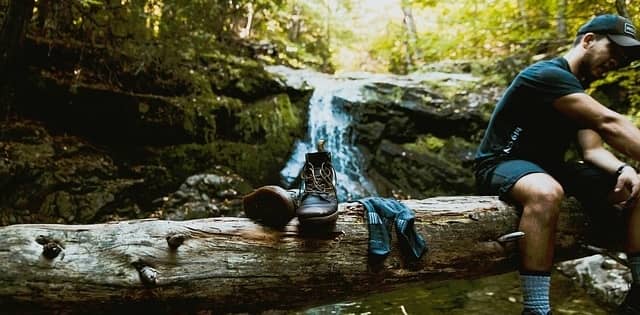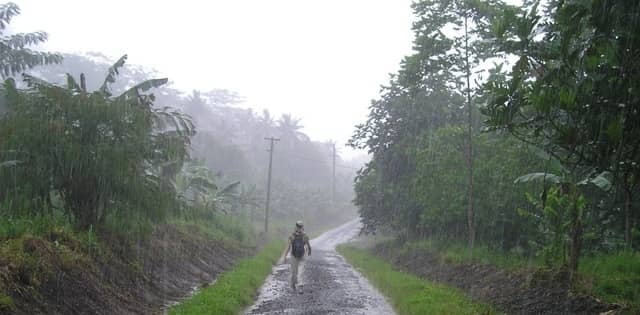What Type of Socks to Wear in Wet Weather
Most times, when people think of footwear, they think of shoes. However, socks are also a major part of footwear, and often not a lot of thought goes into picking out what kind of socks to wear. Actually, socks might even be more important than shoes, because they're the layer that are rubbing directly against your skin.
Choosing a pair of shoes and socks might seem to be a straightforward task, but it isn't always as simple as it sounds. The choice of footwear can be as straightforward as randomly picking up a pair of flip-flops or as complicated as buying specially constructed waterproof socks for a variety of purposes. In fact, sometimes wearing multiple layers of socks is also necessary, depending on the situation.
As far as waterproof socks are concerned, they are used in cases where there is constant exposure to water, cold air, or extremely humid conditions. For instance, if a hike involves multiple crossings through the river or wet land in cold weather, waterproof socks will be your ideal choice. In most situations, however, waterproof socks aren't necessary, as long as you have the right gear for the right purpose.
For instance, waterproof shoes and wool socks over wet land during a hike are just as good. This is because waterproof boots will prevent the water from reaching your wool socks anyway. Similarly, if you're surfing in cold water, booties would be a better option as compared to waterproof socks.
There are multiple shoe/sock combinations for any situation. Basically, it really boils down to one's personal sock/shoe combination preference for different activities. And knowing what are your options is the best way to come up with the combination that's right for you.
A pair of waterproof socks is a good option for you to have in your wardrobe. They can be more economical than other waterproof footwear, they can protect your feet from the elements, and they have multiple uses.

What are waterproof socks made of?
Generally, there are three main elements that go into the making of waterproof socks. These include the exterior knit sock, the waterproof membrane, and an interior knit sock. Both the inner and the outer knit layers of waterproof socks are thick, to prevent abrasion of the waterproof membrane in the middle. Due to this reason, waterproof socks tend to be significantly thicker compared to regular wool socks.
When it comes to waterproof socks, they can be classified into two types in general. These include:
- Waterproof over-socks: As the name suggests, the waterproof over-socks are meant to be worn on top of regular socks. Waterproof over-socks are preferred when it is absolutely necessary to keep the regular socks completely dry such as during a rain in cold weather.
- Waterproof socks: The regular waterproof socks are meant to replace regular socks. Simply put, these socks do not require you to wear a layer of regular socks underneath. These socks tend to have a thicker exterior, a waterproof membrane, and a thinner interior. These socks are primarily used for keeping the feet warm during fishing, surfing, or paddling in cold weather. However, they don't prevent excessive sweating of the feet, which could be an issue.
With respect to changing situations, waterproof socks can further be classified into the following types:
- Toe socks: Waterproof toe socks are primarily made for the purpose of running and hiking. This is because they allow free movement of your ankles.
- Fleece socks: Fleece socks are a cozy and warm waterproof alternative to toe socks that are usually worn underneath regular shoes or sandals. You can even wear these as house slippers. Waterproof socks with a fleece interior tend to have moisture wicking properties. Hence, they are suitable to be worn in summers when your feet are likely to sweat more.
- Heated socks: Heated waterproof socks make use of a low power battery, which provides shock-proof heat to the feet. These are extremely useful for water-related activities in cold weather, such as fishing, or various water sports.

What are the benefits of waterproof socks?
Whether you want to go trail running, hunting, fishing, or hiking, waterproof socks are extremely beneficial. In fact, waterproof socks are suitable for all kinds of outdoor activities that involve unwanted exposure of feet to the water. Below, we have listed a number of general benefits that waterproof socks have over regular socks.
- Practicality
The first benefit that waterproof socks have over regular wool socks is the practicality. Waterproof socks tend to be highly practical and extremely durable. Apart from providing great protection from water, they also provide your feet with the right level of comfort, so you can continue with your wet weather activities.
Another aspect of practicality is that they can be used for a wide variety of activities. Whether you want to walk to work in rainy weather or have to run through a wet trail, a pair of waterproof socks will do the trick in keeping your feet dry.
- Protection form the elements
Another obvious benefit of waterproof socks is that they protect your feet from getting wet. When you wear a pair of waterproof socks, you can walk outside with total assurance that your feet will not get wet from rain or snow.
On top of that, they also help in keeping your feet warm in cold weather. This can help prevent a number of health conditions that result from having cold, wet feet.
Indeed, waterproof socks are real game changers in protecting your feet.
- Multiple Uses
Do their specific structure, you might feel like waterproof socks are limited to a range of activities. However, the truth is that they make a great substitute for regular socks. That's why you can use them in all kinds of situations, such as walking to work, hiking, trail running, fishing, hunting, cycling, and sports including soccer, basketball, and a lot more! Simply put, there is literally no activity restriction for using waterproof socks.
How to make your pair of waterproof socks last longer?
A pair of waterproof socks certainly costs more than a regular pair of let's say, wool socks. This is obviously due to the added technicalities that go into their production. That's why you'll want to take proper care and maintenance of your pair in order to make them last longer.
Here are some tips on taking care of your waterproof socks:
1. Always wash your waterproof socks after use. Pollutants that include road grime and dirt can result in the deterioration of the inner waterproof membrane. In case the waterproof membrane gets damaged, your socks won't remain as effectively waterproof and may only resist water to a limited extent.
The best way to wash waterproof socks is to machine wash them in a gentle cycle. Also keep in mind that fabric softeners, bleach, and regular detergents are likely to leave a residue on the inner membrane which can again damage it. Instead, use detergents that are specifically designed for waterproof fabric. These specifically designed detergents do not leave behind any residue, which makes them safe for washing waterproof footwear.
2. Avoid exposure to an excessive amount of heat. This is because heat is likely to damage your pair by deteriorating the waterproof membrane and the fabric of the exterior/interior layers.
3. Put good care in the storage of your waterproof socks. The best way to store a pair is to hang them upside down or lay them flat. Folding them in between heaps of clothes can damage their form permanently.
4. Be kind to your waterproof socks. While most waterproof socks are built strongly enough to withstand general wear and tear, it is recommended not to use them without slippers or indoor shoes inside the home. This is because no matter how strong the material is, direct friction against the floor (from walking/running) can quickly damage the exterior followed by abrasion of the waterproof membrane inside.

5. Treat stains quickly and correctly. If you've gotten a stain on your waterproof socks, don't treat it with regular detergent or fabric conditioners. Waterproof fabrics are to be washed with specifically designed detergents available in the market. You must avoid harsh chemicals such as bleach for cleaning purposes.
To keep stains away from the interior of your waterproof over-socks, make sure your under-socks are clean and dry. This will prevent the deposit of colors. As an added precaution, do not treat your waterproof socks along with regular socks in order to avoid the deposition of color/dye.
6. Perk up your DWR. DWR stands for 'Durable Water Repellant'. The DWR is what is primarily responsible for rolling the water off. Due to constant usage and regular washing, the DWR fades over time. To combat this, you can treat the waterproof fabric with a DWR spray. These sprays are designed to perk the DWR up on breathable waterproof fabrics. The Nikwax TC Direct Spray is a suitable treatment candidate.
Waterproof socks may not be your choice of daily footwear, but they are a great option to have in your wardrobe, especially if you spend a lot of time outdoors in different types of wet conditions. So when you're picking out foot wear for your next outdoor activity, don't forget to consider if a pair of waterproof socks is the right choice for you.
What Type of Socks to Wear in Wet Weather
Source: https://www.keepdryfeet.com/waterproof-socks-what-you-need-to-know/
0 Response to "What Type of Socks to Wear in Wet Weather"
Post a Comment